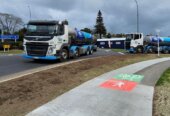In my line of work “I have a dumb question” is usually followed by a great question that has a complicated answer.
“How do volcanoes erupt?” is one of these, and really should be explained before all of the other interesting things I want to cover. What is a volcano? It is a point on the surface where magma comes out, either as ash (pulverized rock), lava flows, or several other exciting and dangerous processes like pyroclastic flows (more on these in future columns). Mountains form when the erupted materials build up around the vent, or multiple vents.
We can group eruptions into types using several definitions. The style of eruption largely depends on the type of magma, especially how sticky or viscous it is, and how much gas is within it. The style can change during one eruption, and each “type” of volcano produces a range of styles. That stuff we learn in school about volcano types (shield, stratovolcano, etc) producing a particular style is not true.
We can break eruptions down into effusive and explosive. Effusive is when we have lava flowing out at the vent (like at Kīlauea, Hawai’i), explosive is when the magma is being violently blown apart into bits of rock. We can also take water into account. Phreatic eruptions are driven by steam (like what happened at Whakaari on that awful day), and magmatic is where magma itself comes out at the surface. We can also have magma and water mix in a particular way that can produce a phreatomagmatic eruption, which can be much larger than expected, like what we saw and possibly even heard from Tonga last year.
Gas is important. Below the surface, magma contains gases that come out to form bubbles when pressure is reduced. This can happen when magma moves into shallower areas of the crust, or during an eruption when it is suddenly at the atmospheric pressure we live in. This is similar to opening a bottle of coke. In the pre-opened, pressurised bottle we can’t see the bubbles as the gas is within the liquid, then when we take the lid off it reduces the pressure and bubbles form.
The next complication is how easily bubbles form and move within the magma. In a runny or less viscous magma like at Kīlauea, gas can form bubbles and move away into the crust easier, so we don’t often get explosive eruptions. More viscous magmas, like we see at Ruapehu, tend to erupt explosively because the gas can’t escape as much before it erupts then… boom However, if the magma has been sitting there for a long time the gas can slowly seep away, leading to an effusive eruption with thick, slow lava flows or domes. Or it never erupts at all and slowly crystallizes into something like a granite.
It is not as simple as just releasing pressure either. Volcanoes are what we call open systems, not a closed bottle of coke. They are constantly evolving on much larger space and time scales than we live in, and we work together around the world studying every teeny tiny part of them to understand the whole.
Good question, complex answer.










